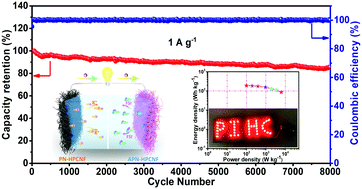Hierarchical porous carbon nanofibers for compatible anode and cathode of potassium-ion hybrid capacitor†
Abstract
The development of electrode materials with the capability of balancing kinetics and capacity between a battery-type anode and capacitor-type cathode is still a grand challenge for potassium-ion hybrid capacitors (PIHCs). Herein, we report the design and synthesis of phosphorus/nitrogen co-doped hierarchical porous carbon nanofibers (PN-HPCNFs) that feature desirable one dimensional (1D) structure and favorable electrochemical properties for PIHC application. We demonstrated that the as-prepared PN-HPCNFs presented a highly attractive performance in terms of capacity or capacitance and durability as both the battery-type anode and capacitor-type cathode of PIHCs, which endows it with great potential for practical application in full PIHCs by delivering a high energy density of 191 W h kg−1 and a high power output of 7560 W kg−1 as well as an ultralong lifespan (82.3% capacity retention after 8000 cycles). Systematic characterization analysis and first-principle calculations demonstrated that the hierarchical pores in the 1D structure, heteroatom P/N co-doping, and enlarged interlayer graphite spacing in the APN-HPCNF contributed synergistically to the outstanding electrochemical performance of PIHCs.

- This article is part of the themed collection: Energy & Environmental Science Cover Art


 Please wait while we load your content...
Please wait while we load your content...